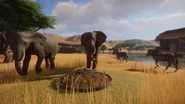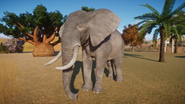The African Savannah Elephant or African Bush Elephant (Loxodonta africana) is a very large African pachyderm featured in the Standard Edition of Planet Zoo.
Zoopedia Description[]
General[]
Population in the Wild: 415,000
Native to the savannahs, forests and mountains of Sub Saharan Africa, the African elephant (or Loxodonta africana) is a large, thickset mammal with grey skin and a characteristic trunk used for vocalizing, drinking and grasping food. Both sexes of the species have tusks, and both are known for their intelligence and strong social bonds, especially the bond between mothers and their babies. Female herds bond for life and, even if a herd splits up, the females will remember and communicate with family members they may come across later in life.
L. africana is a vulnerable species, threatened by poachers of the illegal ivory trade, but also due to the expansion of human life destroying their habitat. It's quite common that they are viewed negatively by locals, mostly because they can destroy farmland and it's hard to 'elephant proof' land with sufficient boundaries. Fortunately, recent conservation efforts have meant that African elephant population is on the rise. Elephants that live in National Parks are now protected from poaching and hunting, and many African countries have introduced humane ways of preventing elephants from damaging farmland. One method is to build a 'beehive fence'; elephants are extremely afraid of bees and will avoid areas containing them.
Social[]
Elephants are social animals, the exception being mature males who usually live alone. Females live in closely bonded family herds - including their young - and will travel and forage together. Herds have a matriarch; an older female who uses her experience to guide the group, and the group will care for each other, helping to raise babies. Elephants have even been known to grieve at the death of a group member. African elephants may travel 50 miles a day searching for food, water and mates.
Reproduction[]
To reproduce, a mature male will approach female herds. Any interested female will vocalize towards him; in response he will chase her until she allows him to mate. An elephant's pregnancy lasts 22 months, at which point the female will give birth to a single calf that she will take very close care of. Other female elephants will also help a mother care for her young, too. These calves will remain close to the family herd until they are around 8 years old, at which point the females will remain and the males will move away to form bachelor pods.
Animal Care[]
Habitat[]
Elephants should be given a large amount of space to roam within their habitat, and be kept in herds made up of primarily young and mature females to stimulate their natural social behaviors. Foliage should be provided which is native to the grassland, aquatic, and tropical environments of Africa, but should not be so dense as to prevent the elephant from roaming. African elephants also seem to enjoy swimming, so water may be provided which is deep enough for them to swim in.
|
PREFERRED OBJECTS | |
|---|---|
|
Hay · Kibble · Fruit and Vegetables | |
|
FEEDING STATIONS | |
|
FOOD ENRICHMENT |
HABITAT ENRICHMENT |
|
COMPATIBLE ANIMALS |
|---|
|
African Savannah Elephant doesn't benefit from sharing space with other species. |
Trivia[]
Zoopedia Fun Facts[]
- An African elephant's tusks grow throughout its life; an adult male's can grow 2.8 inches per year.
- In Tanzania, there is an island that has been dubbed 'Elephant Island' by locals because elephants will swim there to eat palm leaves and coconuts.
- African elephants will give themselves mud baths by spraying water and soil over their backs to protect them from the sun.
- Male elephants go through a periodic state called 'musth', a time of heightened aggression and fertility due to an increase in testosterone.
- African elephants are very important seed dispersers; the seeds of the plants and trees they eat are spread far and wide in their dung.
Other Trivia[]
- There are actually two species of elephants native to Africa, making the term "African elephant" somewhat vague. The species featured here is specifically the African bush elephant. Although this was fixed in the 1.7 Update when the species in game name was changed to "African Savannah Elephant".
- As of March 25, 2021, the African Bush Elephant is now listed as "Endangered" under the IUCN Red List.
- The African Savannah Elephant is the largest extant land animal in the world by mass.
- The species name was originally proposed as Elephas africanus by Blumenbach in 1797. The current genus name Loxodonta means "diamond-toothed", and uses molar dentition to distinguish African elephants from Indian elephants (genus Elephas).






















